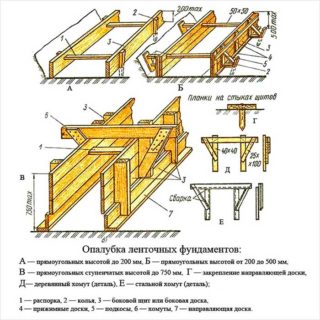An auxiliary structure made of various materials gives shape to concrete products and determines their location in space. Formwork for the foundation is made of elements that limit the dimensions, support the building mixture until it hardens. The auxiliary structure is usually disassembled after curing, and the non-removable shell becomes part of the base.
- Conditions for assembling the formwork for the foundation and its functions
- Formwork device
- Drawing and diagram
- The choice of material for formwork
- Metal
- Reinforced concrete
- Expanded polystyrene
- Wood
- Varieties of formwork for the foundation
- Detachable
- Non-removable
- Collapsible
- Small-shield
- Sliding
- Features of the calculation of the formwork
- Preparatory stage and do-it-yourself production technology
- Do-it-yourself foundation formwork installation
Conditions for assembling the formwork for the foundation and its functions
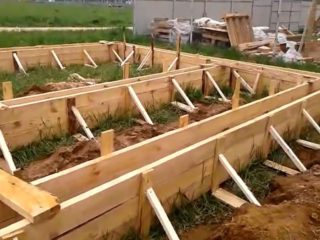
The construction formwork for the strip foundation must be strong and have stable dimensions. The texture of the future base and the number of cracks on the surface depend on the quality of the inner plane. Precision assembly is essential for assembly.
The formwork performs the following functions:
- controls the shape of the concrete mass before solidification;
- evens out the texture of the foundation surface;
- isolates the base from the ground.
Installation and use of formwork is regulated by Gosstandart No. 52085 - 2003 “Formwork. General technical conditions ", which began to be applied by the decree of the State Construction Committee of Russia dated May 22, 2003, No. 43.
Formwork device
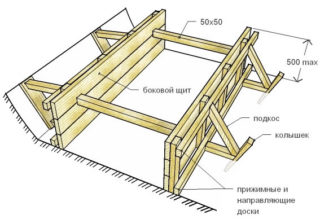
The formwork is assembled from separate parts, the formwork is made from wood, metal, and other material. The inside is cleared of debris and leveled to minimize the finishing process.
Attention is paid to the strength of the connection of fasteners to each other, because the concrete mass is heavy and can compromise the integrity of the structure. The base of the house is formed correctly if the shell does not allow water to pass through. The height of the auxiliary structure is made more than the level of the foundation by 15 - 20 cm. The shields are reinforced with wooden posts, which are hammered into the ground and placed every 0.7 - 1.0 meters.
Drawing and diagram
Foundation concreting includes the choice of the type of formwork and the execution of schematic markings in the plan for its accurate installation. Great importance is attached to the laying of the foundation, the process is supervised by specialists, and the installation begins with the design.
Forming system drawings are developed taking into account:
- the size and material of the shields;
- fasteners.
Formwork assembly diagrams are part of the PPR production project, which also includes plans for placing tape elements, organizational charts with a reference to time, and process maps. The marking drawing contains a strategy for the arrangement of elements with reference to the central axes of the building by numbers.
The choice of material for formwork
The restrictive structure is selected taking into account the type of foundation, its massiveness, length, and the type of concrete. The material must be affordable and affordable.
Specialized types are used:
- wood;
- metal;
- reinforced concrete;
- expanded polystyrene.
Small bases are poured using improvised means, for which you do not need to spend money. For example, old boards, dismantled door leaves, furniture parts, pieces of slate are used.Formwork from such items is difficult and not always popular, because it is difficult to find the appropriate parts and sizes.
Metal
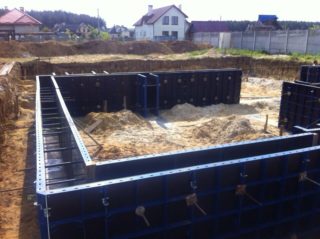
The metal form is a suitable option for monolithic and tape bases. Reinforcement struts are welded to steel panels, resulting in a reliable collapsible structure, the blocks of which are bolted. Galvanized or galvanized metal is also used. The coating on the steel surface protects the material from corrosion, therefore, such shields are reversible, easy to clean and remove.
Aluminum sheets are lightweight and convenient in construction production, but have a high cost. The material differs from steel in less strength and increased fluidity, therefore it quickly loses its shape. Aluminum panels are almost never repaired, so their use is limited.
Reinforced concrete
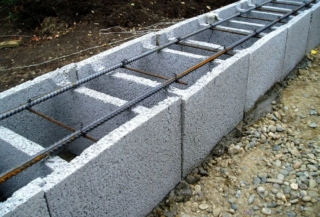
Such formwork is unconventional, rarely installed due to the complexity of installation and high cost. To make the formwork correctly, ready-made reinforced concrete slabs are taken. The advantages include the fact that the powerful shell is not removed and allows to reduce the transverse dimension of the foundation body.
Another option for a reinforced concrete shell is the case when a reinforced layer is concreted on top of fixed foam slabs or other liner made of plastic material. A mesh of metal rods encloses the insert on both sides and is connected with wire pallets. The concrete is applied by spraying using special equipment.
Expanded polystyrene
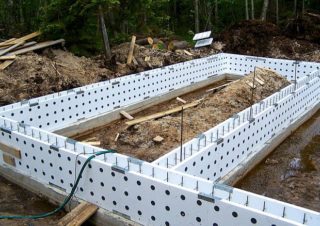
A shell made of this material stably retains its technical properties during operation over a long period of operation of the building. The formwork has high strength and protects concrete from freezing and moisture in harsh climates.
Plates of expanded polystyrene grade PSB-S with a density of 25 - 35, a thickness of 40 - 100 mm must be set in the design position in accordance with the step-by-step instructions. The slabs are connected by monolithic partitions. The overlying blocks are engaged with the lower elements due to special locks, and concrete is laid in the inner space.
Wood
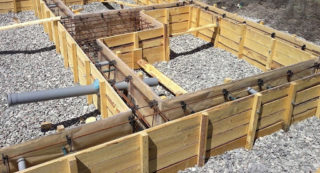
Used boards or boundary sheets made of chipboard, OSB with moisture impregnation. Plywood formwork for the foundation is assembled using screeds and wooden supports, which are connected with nails or screws. The blocks must be placed in rows so that there are no voids between them, and limit plates must be installed at the end according to a similar principle.
The top of the structure is tied with reinforcement so that the concrete does not collapse the edges. A frame made of reinforcement or a mesh of metal rods is installed inside. Heat-resistant foam liners are adopted to coordinate the thermal resistance. Concrete is poured into the resulting space, after hardening, the shields are removed.
Varieties of formwork for the foundation
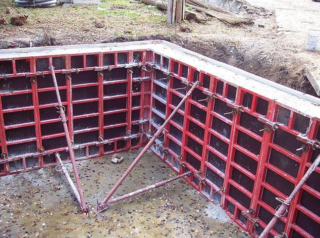
According to its intended purpose, the shell is vertical, for example, formwork for a columnar foundation, and horizontal. The sheer structure moves upward as it is filled with concrete, like pouring a pile foundation.
The frame system consists of panels on a metal frame and supports, connected by nails, bolts, screws. The design is rigid and has been used many times. The beam system includes formwork panels, beams, girders, scaffolding, where the elements are joined by welding. This design is used for the construction of walls, but it is not used for concreting the foundations.
Detachable
Replaceable systems differ only in material, because the structure is always made the same and contains decks, a connecting belt, struts and braces. In construction, modular or inventory options for shields are used, which are manufactured at the factory.Such formwork is quickly assembled, removed and is characterized by high accuracy of geometric dimensions.
In private housing construction, the turnover of the structure does not play a role, therefore wood is more often used, for example, the formwork of a strip foundation is made from a board. Once removed, the material will no longer be applied.
Inventory formwork can be rented if such a decision is economically justified.
Non-removable
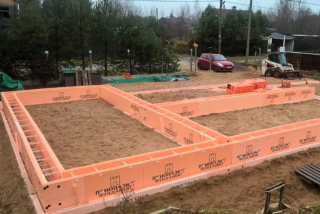
The structure consists of easy-to-assemble formwork parts, which, after the concrete hardens, go into the category of working elements and perform the specified functions. The shell protects the foundation from soil liquid, the base can withstand freezing and thawing without destruction.
Factory modules are used, which are made with grooves and tenons in the appropriate places. The outer supports are not used because inner inlays hold the structure and provide resistance to stress. Most often, non-removable options are made of materials that save heat and poorly transmit moisture, but metal, fiber-reinforced concrete, porcelain stoneware or plastic are also used.
Collapsible
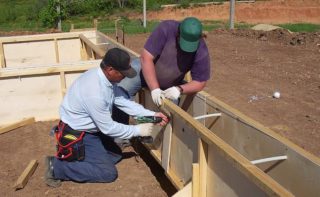
The system is intended for disassembly after application and transfer to the next plot. You can design such a formwork for the foundation with your own hands, purchase a reversible one on the market or rent it. The formwork consists of panels and a load-bearing frame. Supports, braces support the boards in the working position so that the concrete does not spread during the hardening process.
The collapsible version differs in the way the elements are fastened. The shields are connected with bolts, which are removed if necessary, and the stationary formwork is fastened with nails or by welding the frame, which makes it impossible to remove it without destruction.
Small-shield
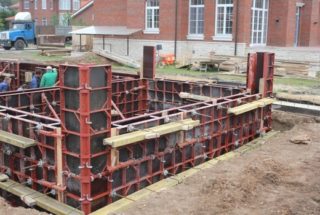
The design is used on small objects so as not to use cranes for installation. Shields weighing less than 50 kg are placed manually in the design position in the construction of private houses, where a large amount of concrete work is not provided for pouring the base.
The small-panel formwork contains elements of standard sizes, is connected by the impact lock method and by means of clamping screws. The advantage of the device is its multiple use and long service life. Workers' labor is saved, the installation technology is clear and simple, each element has grooves, mounting holes for fitting parts.
Sliding
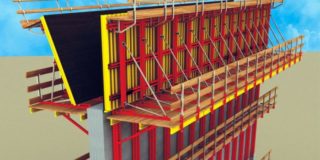
This type of shell is rearranged in height and is used in the construction of buildings with monolithic concrete walls and columns. Rigid shields of the selected design are fixed at a certain height, concrete mixture is fed inside. After hardening, the shell is disassembled and rearranged higher to accept a new portion.
For rearrangement, jacks, hoists, lifts are used.
The use of sliding formwork is effective in buildings with a constant perimeter of walls in the plan and for structures with a minimum number of window and door openings, for example, walls of elevators, water towers, lighthouses.
Features of the calculation of the formwork
Standard calculations boil down to determining the number of boards or sheets of chipboard and comparing their cost. For this, the area of the side wall of the strip foundation is divided by the area of the element. For example, the surface of the base on the side is 7 m² (length - 10 m, height - 0.7 m). The board has an area of 0.9 m² (length 6 m, width 0.15 m). The number of boards is 7 / 0.9 = 8 boards (7.77).
Usually in a private house 40 - 50 pieces of boards are taken per 1 m³ of concrete mix. For this, the volume of the entire foundation is calculated. It is equal to the perimeter multiplied by the height and width of each freestanding or turning section, then the volumes are added.
Preparatory stage and do-it-yourself production technology
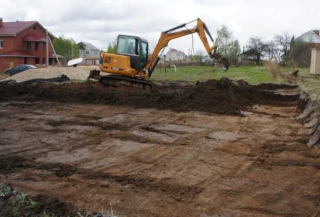
The initial stage includes the acquisition of materials, preparation of the instrument. Before the do-it-yourself formwork is installed, you need to level the construction area.
The operation includes:
- cutting off plant soil;
- digging trenches;
- cleaning the bottom of the pit to the design level.
The ditch for the strip base or the pits for the posts are selected so that there is a 10-15 cm margin on the sides for installing the shields together with the spacers. Vertical barriers for flat screens are installed after the installation of sand and crushed stone filling at the bottom of the trench.
Do-it-yourself foundation formwork installation
Step-by-step sequence of actions:
- installation of vertical racks;
- hinge and fastening of shields;
- installation of stops and connection of the upper edges.
Shields are hung on vertical bars so that no gaps of more than 5 mm appear between them, through which moisture from the concrete will flow away. Stops and braces are placed to strengthen the formwork, boards or bars are used.
The encircling frame is placed in two tiers, at the bottom (height 10 cm) it perceives the initial load from the concrete, and at the top (40 cm) it will simultaneously protect the shields from spreading to the sides. The inner surface of the formwork is covered with polyethylene to prevent leaks and moisture absorption into the wood.

